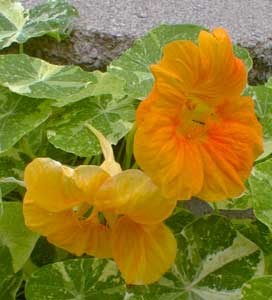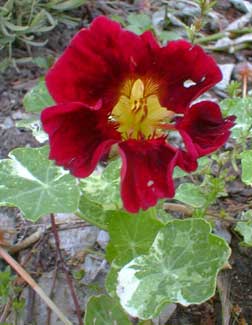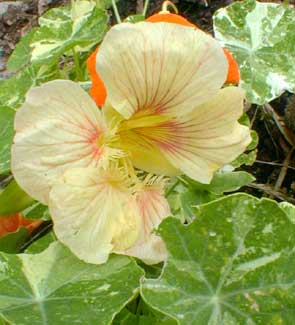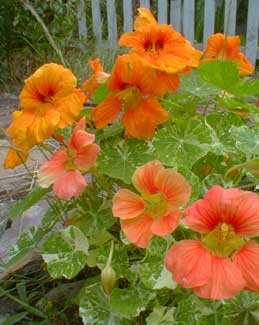
Alaska Mix
Variegated Dwarf
Single Nasturtiums
"Flame-flower, Day-torch, Mauna Loa,
I saw a daring bee, today, pause, & soar,
Into your flaming heart."
from "Lines to a Nasturtium"
by Anne Spencer
(1882-1976)
by Anne Spencer
(1882-1976)
 Spurred nasturtium flowers are edible in salads or as garnish alongside or atop just about any dishes or on sandwiches in lieu of lettuce. The blooms have a watercress-like flavor & are rich in Iron & Vitamin C.
Spurred nasturtium flowers are edible in salads or as garnish alongside or atop just about any dishes or on sandwiches in lieu of lettuce. The blooms have a watercress-like flavor & are rich in Iron & Vitamin C.'Alaska' dwarf single nasturtiums are self-seeding annuals, bushing to a foot high & wide per plant, rather than with runners, quite a bit smaller than for the species.
This heirloom variety has variegated leaves, so is very attractive even before it flowers, its lilypad-like round leaves marbled or streaked with creamy white.
 In regions with warm winters they are tender perennials. They are largely a no-maintenance ultra-easy flower that just needs its pea-seeds popped a quarter inch into the ground, six inches apart, then forget about 'em.
In regions with warm winters they are tender perennials. They are largely a no-maintenance ultra-easy flower that just needs its pea-seeds popped a quarter inch into the ground, six inches apart, then forget about 'em.To be sure of a good crop a second year, the seedpods when ripened on the vines can be broken open to save the peas, & plant them in spring two weeks before last frost; or in autumn in frost-free climates, for winter bloom.
On Puget Sound, spring-planted peas flower in June & continue throughout summer & into early autumn (we've had the random bloom appear as late as November). The are variously colored dark blood-red, yellow, pale yellow, red-orange, & yellow-orange (or gold).
 Nasturtium blooms best in full sun, but is still fairly floriferous in partial shade. Shade increases the likelihood of attracting powdery mildew, though, so I wouldn't recommend it unless in a region where humidity is naturally extremely low; otherwise full sun will just all-round be more rewarding with nasturtiums.
Nasturtium blooms best in full sun, but is still fairly floriferous in partial shade. Shade increases the likelihood of attracting powdery mildew, though, so I wouldn't recommend it unless in a region where humidity is naturally extremely low; otherwise full sun will just all-round be more rewarding with nasturtiums.They are not fussy about soil, but rich soil will cause increased foliage production which can hide the bright little flowers. For the same reason nasturtium should not be fertilized with anything containing nitrogen, as it does not increase flower strength to feed this plant. A mild phosphorus fertilizer wouldn't hurt, but is very far from necessary.
The genus name Tropacolum means "Trophy." This name was conferred by the Swedish botanist Carl Linnaeus (1707-1778), who saw nasturtiums growing on a post, & was reminded of the tradition of war victors hanging their weapons in trees. To Linnaeus the leaves looked like shields, & the flowers looked like helmets.
Bees & hummingbirds like the bright flowers, but alas so also do black aphids. There is a belief that to grow nasturtiums outside the garden attracts all the aphids away from the main flowers, though just as likely they'd provide a breeding ground for aphids.
Sometimes toward year's end the only thing one can do is pull out the nasturtiums & get rid of them, as the aphids will just be so thick, & getting insecticidal soapy sprays up underneath those low round leaves is just about impossible.
See also
Trailing Single Nasturtium
Trailing Single Nasturtium